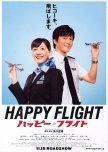Flight 1980 to Honolulu
Everything that you’ve ever wanted to know about the technical and operational aspects of the aviation industry can be found in this movie. But don’t worry about getting confused or overwhelmed because the whole concept is conveyed in layman terms and in a very entertaining manner. The running time of about 100 minutes will quickly fly by without you noticing it.
Based on the original screenplay by Yaguchi Shinobu, who also directed the film. Tokusho Kikumura (Ju-on film series) serves as cinematographer while Japanese musician Mickie Yoshino composed and arranged the music, which features Frank Sinatra’s Come Fly With Me as the theme song. Tokusatsu productions’ special effects director Hiroshi Butsuda and VFX specialist Koichi Noguchi (Tokusatsu Research Institute) are involved in the production.
All Nippon Airways (ANA) collaborated substantially on the project through the use of their commercial airliner (Boeing 747-400), equipment, personnel uniforms and hangar at Haneda airport (aka Tokyo International Airport). ANA even contributed their technical expertise to the screenplay and assembled a team to oversee the filming. The director himself researched extensively by travelling to the home of Boeing in Seattle in a bid to ensure the key elements of the story stay true to factual accuracy as much as possible.
This film was heavily promoted where 25 cities and airports all over Japan hosted the marketing campaign in 2008. Additionally the US premiere screening was held at Boeing headquarters in Seattle, Washington and attended by Joseph F. Sutter, the developer of the Boeing 747. The success of this film helped spawn 5 side stories as well as a number of TV programs and books.
What I Loved
I absolutely adore the story and the storytelling approach. I would consider this production as semi-comedic, cheerful with lighthearted undertones, highly educational and definitely moving with a lot of heart and soul. Initially coming across somewhat as a parody of aviation-themed shows, the film gradually settles into a fast-paced and action packed docudrama that consistently holds my attention. I find myself quickly immersed into the multiple perspectives of the myriad colourful characters throughout what has been a truly riveting rollercoaster ride indeed.
The attention to detail in terms of the authenticity of the technicalities involved is quite astounding. In addition to the numerous events that take place at the airport as well as in the airliner en route to Honolulu from Tokyo, viewers are also taken behind the scenes to witness the frenetic activities that go on at the control tower, radar centre and hangar. Real life people are convincingly depicted through smartly-written characterizations that include the pilots, cabin and ground crews, mechanics, air traffic controllers, radar room controllers, operations personnel and even the variety of passengers themselves. Thanks to this movie, I’ve been exposed to new jargon such as purser, pitot tube, birdstrike, and birdman, among others. I’ve even discovered that crows and pigeons are smarter than seagulls which are more likely to crash onto a plane.
Production-wise, the film has aged very well for one that was made in 2008. Neither the visual quality nor the cinematography technique appear dated. The visual effects are generally well rendered, particularly in scenes of mid-air flight. As far as the set designs are concerned, obviously the principal photography took place in an actual plane and the airport, so I have absolutely no complaints on that front.
The film features a large ensemble cast with many familiar faces and each of the portrayals are afforded almost equal screen time. For the most part, the extended focus is on Ayase Haruka and Tanabe Seiichi, who are credited as the leads in their respective roles of the inexperienced flight attendant Saito Etsuko and the young pilot, Suzuki Kazuhiro. I’m a fan of Ayase Haruko who projects a refreshing take with an upbeat and sunny disposition while Tanabe Seiichi delivers a charming and humorous depiction of the Captain-in-training.
Of the supporting cast that caught my attention, the experienced Terajima Shinobu commands the screen with her portrayal of Chief Purser, Yamazaki Reiko. Tabata Tomoko’s Kimura Natsumi is a blur of motion with her lively enthusiasm, and Eguchi Noriko catches the eye with her intriguing air traffic controller, Mizuno Yuriko, despite her limited appearance. Additionally, Ito Aiko mesmerises as Miyamoto Rie, the radar room controller.
Final Thoughts
Do not be fooled by the “fluffy and romcom-esque” poster. Happy Flight is so much more than meets the eye. I was intrigued from the get-go and enthralled all the way to the rousing conclusion of the story. In my humble opinion, this is one of the best-produced, most expansive and detailed contemporary Japanese films I’ve ever had the opportunity to savour. Kudos to the entire production team for a job well done!
Based on the original screenplay by Yaguchi Shinobu, who also directed the film. Tokusho Kikumura (Ju-on film series) serves as cinematographer while Japanese musician Mickie Yoshino composed and arranged the music, which features Frank Sinatra’s Come Fly With Me as the theme song. Tokusatsu productions’ special effects director Hiroshi Butsuda and VFX specialist Koichi Noguchi (Tokusatsu Research Institute) are involved in the production.
All Nippon Airways (ANA) collaborated substantially on the project through the use of their commercial airliner (Boeing 747-400), equipment, personnel uniforms and hangar at Haneda airport (aka Tokyo International Airport). ANA even contributed their technical expertise to the screenplay and assembled a team to oversee the filming. The director himself researched extensively by travelling to the home of Boeing in Seattle in a bid to ensure the key elements of the story stay true to factual accuracy as much as possible.
This film was heavily promoted where 25 cities and airports all over Japan hosted the marketing campaign in 2008. Additionally the US premiere screening was held at Boeing headquarters in Seattle, Washington and attended by Joseph F. Sutter, the developer of the Boeing 747. The success of this film helped spawn 5 side stories as well as a number of TV programs and books.
What I Loved
I absolutely adore the story and the storytelling approach. I would consider this production as semi-comedic, cheerful with lighthearted undertones, highly educational and definitely moving with a lot of heart and soul. Initially coming across somewhat as a parody of aviation-themed shows, the film gradually settles into a fast-paced and action packed docudrama that consistently holds my attention. I find myself quickly immersed into the multiple perspectives of the myriad colourful characters throughout what has been a truly riveting rollercoaster ride indeed.
The attention to detail in terms of the authenticity of the technicalities involved is quite astounding. In addition to the numerous events that take place at the airport as well as in the airliner en route to Honolulu from Tokyo, viewers are also taken behind the scenes to witness the frenetic activities that go on at the control tower, radar centre and hangar. Real life people are convincingly depicted through smartly-written characterizations that include the pilots, cabin and ground crews, mechanics, air traffic controllers, radar room controllers, operations personnel and even the variety of passengers themselves. Thanks to this movie, I’ve been exposed to new jargon such as purser, pitot tube, birdstrike, and birdman, among others. I’ve even discovered that crows and pigeons are smarter than seagulls which are more likely to crash onto a plane.
Production-wise, the film has aged very well for one that was made in 2008. Neither the visual quality nor the cinematography technique appear dated. The visual effects are generally well rendered, particularly in scenes of mid-air flight. As far as the set designs are concerned, obviously the principal photography took place in an actual plane and the airport, so I have absolutely no complaints on that front.
The film features a large ensemble cast with many familiar faces and each of the portrayals are afforded almost equal screen time. For the most part, the extended focus is on Ayase Haruka and Tanabe Seiichi, who are credited as the leads in their respective roles of the inexperienced flight attendant Saito Etsuko and the young pilot, Suzuki Kazuhiro. I’m a fan of Ayase Haruko who projects a refreshing take with an upbeat and sunny disposition while Tanabe Seiichi delivers a charming and humorous depiction of the Captain-in-training.
Of the supporting cast that caught my attention, the experienced Terajima Shinobu commands the screen with her portrayal of Chief Purser, Yamazaki Reiko. Tabata Tomoko’s Kimura Natsumi is a blur of motion with her lively enthusiasm, and Eguchi Noriko catches the eye with her intriguing air traffic controller, Mizuno Yuriko, despite her limited appearance. Additionally, Ito Aiko mesmerises as Miyamoto Rie, the radar room controller.
Final Thoughts
Do not be fooled by the “fluffy and romcom-esque” poster. Happy Flight is so much more than meets the eye. I was intrigued from the get-go and enthralled all the way to the rousing conclusion of the story. In my humble opinion, this is one of the best-produced, most expansive and detailed contemporary Japanese films I’ve ever had the opportunity to savour. Kudos to the entire production team for a job well done!
Was this review helpful to you?


 21
21 35
35 7
7



















